#Black Voting Rights in mississippi
Explore tagged Tumblr posts
Text
The Guardian: ‘You want it to outlive you’: an often-overlooked piece of civil rights history
"WE'VE SEEN IT AND ITS A HISTORY MUST SEE"
Martin Luther King Jr and his march from Selma to Montgomery is familiar to anyone with a glancing awareness of the civil rights movement. But on his way he went through Lowndes county, an often-overlooked hostile territory where a profoundly influential movement for equal rights was born.
With impassioned talking head testimonials and a staggering treasure trove of never-before-seen archival footage, documentary Lowndes County And The Road To Black Power covers the 80% Black population in one of the poorest counties in the US who rallied to register their vote and be heard despite the constant and immediate threat of white supremacist violence. Lowndes is where the college kids who made up the Student Nonviolent Coordinating Committee (Sncc, pronounced snick) went to support the local community and help create the Lowndes County Freedom Organization (LCFO). Their focus was to get Black people elected into positions of power and effect change. Because such practical and immediate goals were a threat to white power, these targeted activists had to arm themselves while moving through an area dubbed Bloody Lowndes.
On their election literature, the LCFO identified themselves with a logo borrowed from Clark-Atlanta University’s mascot: a panther. They were known as the Black Panther party.
Sncc’s story isn’t as widely circulated as say Martin Luther King Jr’s in the history books and popular culture. On a Zoom call with the Guardian, director Geeta Gandbhir, alongside co-director Sam Pollard, says that erasure is intentional. “It’s about a leaderless movement of folks organizing and claiming power in a way that is a threat,” Gandbhir says from her home in Brooklyn. “As Ruby Sales says in the film, Black power is a threat to white supremacy and to the white economic system everywhere.
“The Sncc veterans and also the local Lowndes county people were non-violent in theory, but they were going to defend themselves. They were carrying guns. That kind of movement, which ultimately was very successful and is the key to the freedom struggle, is seen as dangerous by folks who want to maintain the status quo.”
Gandbhir didn’t know the story about Lowndes county before writers and producers Vann R Newkirk II and Dema Paxton Fofang brought the project to her. She was down to direct, but wouldn’t take the project without Pollard because she felt it wasn’t her story to tell.
Gandbhir is Indian American. She cites Mira Nair as an influence, not just because the Mississippi Masala film-maker is a fellow Indian. Nair told stories about Indian Americans in relation to other Bipoc (Black, Indigenous and people of color) communities, not just in their own bubble where they can put on a performance as model minorities while their own anti-Black racism bubbles beneath the surface. Gandbhir carefully acknowledges that while she sees unity in the struggles shared by the Bipoc community, she understands the privilege she has that the Black community doesn’t.
Pollard, a veteran in the industry who cut his teeth as an editorial assistant on Ganja & Hess, has been telling stories about the freedom struggle since making his directorial debut on the PBS series Eyes On The Prize. Lowndes County And The Road To Black Power is far from his first collaboration with Gandbhir. They began working together editing Spike Lee films like Surviving The Game, Girl 6, Bamboozled and When The Levees Broke. According to Gandbhir, they met when she was working as an editorial assistant on Spike Lee’s Malcolm X.
“That’s not true,” Pollard interrupts, from a recording studio in Hell’s Kitchen. “I only worked on Malcolm X for two weeks.” Gandbhir agrees, clarifying that she remembers him from when he came in to briefly help with the edit on Spike Lee’s epic biopic on the passionate civil rights era leader. “I don’t remember her at all,” he says, chuckling in defeat, the comfy groove created by their decades long working relationship is felt in the warm and comical back-and-forth.
“She was my apprentice editor, assistant editor, co-editor,” says Pollard. “Then she became a director and we started directing together. She’s always looking out for projects that she thinks will be interesting because of the social or political points of view.”

She points to an argument made by Kwame Ture, the Sncc organizer who coined the slogan “Black Power”. Then called Stokely Carmichael, Ture pointed out that the Southern Christian Leadership Conference (SCLC) would be lost without their leader, Martin Luther King Jr. “That is the danger where the people didn’t necessarily feel that they themselves had the actual power to impact change,” Gandbhir explains, adding that Sncc’s model ensured that every individual organizer or citizen exerting their voting power recognized why and how their voice matters. “As they say, strong people don’t need strong leaders ... You want the movement to outlive you. Ideally, you’re working yourself out of a job. That was Sncc’s concept of organizing and one that we need today.”
I turn the conversation to some of today’s activists, specifically those who have achieved internet notoriety. The day before this interview, Ziwe, the comic talkshow host who knows how to capitalize on awkward silences, aired her interview with DeRay Mckesson. He’s an activist who was on the ground at Ferguson, allied with Black Lives Matter and founded the police reform movement Campaign Zero. Ziwe asked Mckesson about a fellow celebrity activist Shaun King, who has been criticized for allegedly mismanaging money and capitalizing on his clout. Mckesson, who has also received his fair share of criticism, talked about how fame could erode activism, as Ziwe raised a pointed eyebrow at her guest. A chyron onscreen punctuated the irony, paraphrasing the famous activist as saying: “Fame is bad for activism.”
I ask Gandbhir and Pollard, given the tenets learned from Lowndes county, about their thoughts on these activists and some of the organizational criticism in today’s movements. Pollard shakes his head, letting out a big “nooooo”. He’s exerting his influence as the wise owl role in the conversation, simultaneously responding to me and warning Gandbhir that it is not her place to respond.
“We’re film-makers,” says Pollard. “It’s not our job to use our film to critique present-day movements.”
I take the query a step further, asking about their thoughts on bad faith players like Candace Owens, the conservative commentator who got Kanye West’s ear, works to discredit movements like Black Lives Matter and sows doubt regarding George Floyd’s murder. Lately, we’ve been inundated by YouTube ads for Owens’ documentary, spreading her arguments to the algorithmically vulnerable.
Pollard and Gandbhir remain wary about addressing any specific players, but remind why it’s important to tell truthful and impactful stories like Lowndes County; stories they feel, again, were suppressed by the powers that be for a reason.
“Disinformation and propaganda has always been a tool used to suppress, oppress and destroy communities and civilizations,” says Gandbhir. “It’s how certain groups feel that they can win.
“One group tells you it’s raining. The other group tells you it’s not raining. Our job is to go outside and see if it’s raining. That’s how I look at it. That’s what we try to do in the storytelling.”
Lowndes County And The Road To Black Power is now out in US cinemas with a UK date to be announced
#You want it to outlive you’: an often-overlooked piece of civil rights history#Civil Rights History in america#Black Panther Party for Self Defense#voter registration drives#sncc#MLK Jr#sclc#Black History Matters#Lowndes county mississippi#Lowndes county voting registration drive#Black Voting Rights in mississippi#Lowndes
10 notes
·
View notes
Photo




This year marks the 60th anniversary of “Freedom Summer,” the 1964 voter registration movement in Mississippi. More than 700 volunteers mobilized to fight against voter intimidation and discrimination at the polls.
Freedom Summer volunteers were met with violent resistance from the Ku Klux Klan and members of state and local law enforcement. News coverage of volunteers being beaten, arrested, and even killed drew international attention to the civil rights movement.
The Freedom Summer project ultimately registered nearly 1,200 Black Americans to vote in Mississippi, and pushed Congress to pass the Civil Rights Act of 1964 and the Voting Rights Act of 1965.
This year, let's continue their fight to uplift Black voices and Black votes. Join us in registering voters during our Juneteenth Weekend of Action at weall.vote/juneteenth.
#freedom summer#mississippi#voter registration#civil rights movement#1964#civil rights act#voting rights act#black voices#black votes#black lives matter#blm#black history#american history#juneteenth
498 notes
·
View notes
Text
#politics#black crimes#mississippi#jim crow#felony disenfranchisement#civil rights#mass incarceration#voter disenfranchisement#white supremacy#racism#anti blackness#voting rights
58 notes
·
View notes
Text
On August 4, 1964, following several weeks of national news coverage and an intensive search by federal authorities, the bodies of civil rights workers Michael Schwerner, James Chaney, and Andrew Goodman were found in Longdale, Mississippi. The three men, who went missing after being released from a local Mississippi jail, had been shot to death and buried in a shallow grave.
Earlier that year, Michael Schwerner had traveled to Mississippi to organize Black citizens to vote. A white New Yorker working with the Congress of Racial Equality (CORE), Mr. Schwerner worked extensively with a Black CORE member from Meridian, Mississippi, named James Chaney. The activist pair led an effort to register Black voters and helped Mt. Zion Methodist Church, a Black church in Longdale, create an organizing center. These developments angered local members of the Ku Klux Klan; on June 16, while Mr. Schwerner and Mr. Chaney were away, Klansmen torched the church and assaulted its members.
On June 21, Mr. Schwerner, Mr. Chaney, and a new white CORE member named Andrew Goodman investigated the church burning and then headed for Meridian, Mississippi. Knowing that they were in constant danger of attack, Mr. Schwerner told colleagues in Meridian to search for them if they did not arrive by 4 pm. While passing through the town of Philadelphia, Mississippi, the three men were stopped by Neshoba County Deputy Sheriff Cecil Price.
A member of the Ku Klux Klan, Mr. Price had been monitoring the activities of the civil rights workers. He arrested the men on traffic charges and held them in jail for about seven hours before releasing them on bail. Mr. Price escorted Mr. Schwerner, Mr. Chaney, and Mr. Goodman out of town but soon re-arrested the men and held them until other Klansmen could join. They were not seen alive again.
When the three activists did not arrive in Meridian, they were reported missing and soon became the subjects of a highly publicized FBI search and investigation. As the days turned into weeks, some Mississippi officials and white segregationists accused civil rights leaders of fabricating the workers' disappearance to gain support for their cause. Once the three men's bodies were discovered on August 4, however, no one could deny their fates.
While their disappearance resulted in national news stories, Michael Schwerner’s wife and fellow CORE worker Rita Schwerner, admonished reporters in 1964: “The slaying of a Negro in Mississippi is not news. It is only because my husband and Andrew Goodman were white that the national alarm has been sounded.” Indeed, investigators searching Mississippi’s woods, swamps, and rivers that summer found the remains of at least two more Black men: Henry Dee and Charles Moore, college students who were kidnapped, beaten and murdered in May 1964.
#history#white history#us history#am yisrael chai#jumblr#republicans#black history#democrats#Michael Schwerner#James Chaney#Andrew Goodman#Longdale#Mississippi#vote#civil rights#Henry Dee#Charles Moore#FBI#CORE#Rita Schwerner#right to vote#voters rights#voter registration#voter#voter fraud#voting rights#voter suppression#end the apartheid#american apartheid#apartheid
2 notes
·
View notes
Text

#trieyemedia#photography#fannie lou hamer#hometown hero#mississippi#black history#civil rights movement#voting rights#poverty#poetryblues#human rights
17 notes
·
View notes
Text

👊🏾 “Freedom is never free.” ~ Medgar Evers (1925-1963) ✊🏾🇺🇸
#Medgar Evers#voting rights#voting rights in Mississippi#NAACP#civil rights#historical caricature#character design#world war ii#Jackson Mississippi#the kidnapping and murder of Emmett Till#freedom isn’t free#Black History Month 2023#President Kennedy#the Civil Rights Movement#Ole Miss#Emmett Till
4 notes
·
View notes
Text
Civil rights
In the summer of 1962, Lyon hitchhiked to Cairo, Illinois, to witness demonstrations and a speech by John Lewis, chairman of the Student Nonviolent Coordinating Committee (SNCC), one of the most important organisations driving the civil rights movement of the early 1960s. Inspired to see the making of history firsthand, Lyon then headed to the South to participate in and photograph the civil rights movement. There, SNCC executive director James Forman recruited Lyon to be the organisation’s first official photographer, based out of its Atlanta headquarters. Traveling throughout the South with SNCC, Lyon documented sit-ins, marches, funerals, and violent clashes with the police, often developing his negatives quickly in makeshift darkrooms.
Lyon’s photographs were used in political posters, brochures, and leaflets produced by SNCC to raise money and recruit workers to the movement. Julian Bond, the communications director of SNCC, wrote of Lyon’s pictures, “They put faces on the movement, put courage in the fearful, shone light on darkness, and helped make the movement move.”
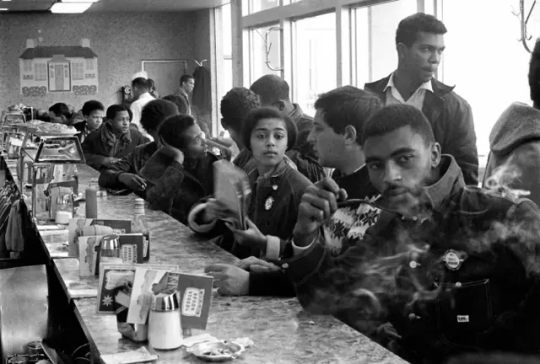
Danny Lyon (American, b. 1942)Student Nonviolent Coordinating Committee (SNCC) Sit-In, Atlanta 1963 Gelatin silver print Image: 16.1 x 24cm (6 3/8 x 9 1/2 in.) Sheet: 20.3 x 25.4cm (8 x 10 in.) Collection of the artist
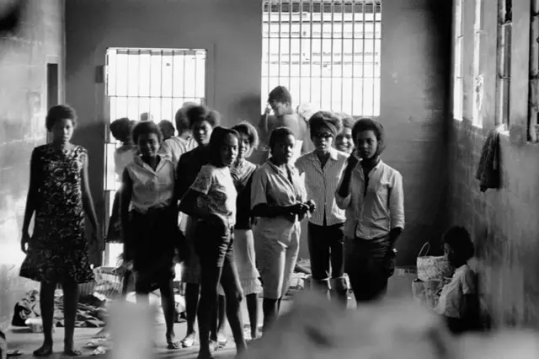
Danny Lyon (American, b. 1942)The Leesburg Stockade, Leesburg, Georgia 1963 Gelatin silver print Image: 17.5 x 26cm (6 7/8 x 10 3/16 in.) Sheet: 27.9 x 35.6cm (11 x 14 in.) Collection of the artist
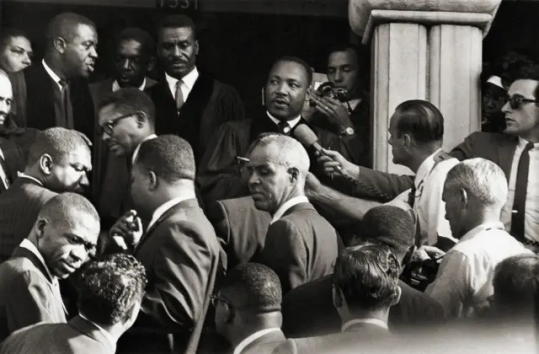
Danny Lyon (American, b. 1942) Abernathy, Shuttlesworth (SCLC), King and Wilkinson (NAACP) 1963 Gelatin silver print

Danny Lyon (American, b. 1942)Voting Rights Demonstration, Organized by the Student Nonviolent Coordinating Committee (SNCC), Selma, Alabama October 7, 1963 Gelatin silver print Image: 18.3 x 26.8cm (7 3/16 x 10 9/16 in.) Sheet: 27.8 x 35.4cm (10 15/16 x 13 15/16 in.) Whitney Museum of American Art, New York; purchase with funds from the Photography Committee
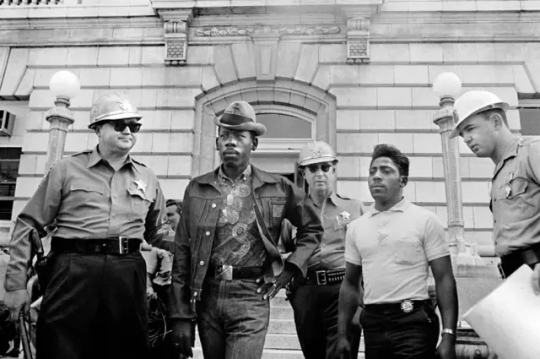
Danny Lyon (American, b. 1942)Sheriff Jim Clark Arresting Demonstrators, Selma, Alabama October 7, 1963 Gelatin silver print Image: 18.4 x 27cm (7 1/4 x 10 5/8 in.) Sheet: 27.8 x 35.4cm (10 15/16 x 13 15/16 in.) Whitney Museum of American Art, New York; purchased with funds from the Photography Committee
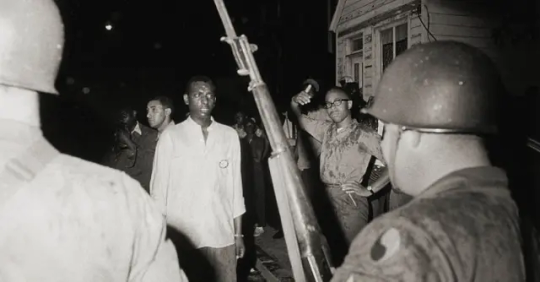
Danny Lyon (American, b. 1942)Stokely Carmichael, Confrontation with National Guard, Cambridge, Maryland 1964 Gelatin silver print Image: 16.5 x 22.2cm (6 1/2 x 8 3/4 in.) Sheet: 20.3 x 25.4cm (8 x 10 in.) Collection of the High Museum of Art, Atlanta; purchase with funds from Joan N. Whitcomb

Danny Lyon (American, b. 1942) Woman Holds Off a Mob, Atlanta 1963 Gelatin silver print

Danny Lyon (American, b. 1942) Bob Dylan behind the SNCC office, Greenwood, Mississippi 1963 Gelatin silver print

Danny Lyon (American, b. 1942)Arrest of Taylor Washington, Atlanta 1963 Gelatin silver print 24 x 16cm (9 7/16 x 6 1/4 in.) Collection of the artist
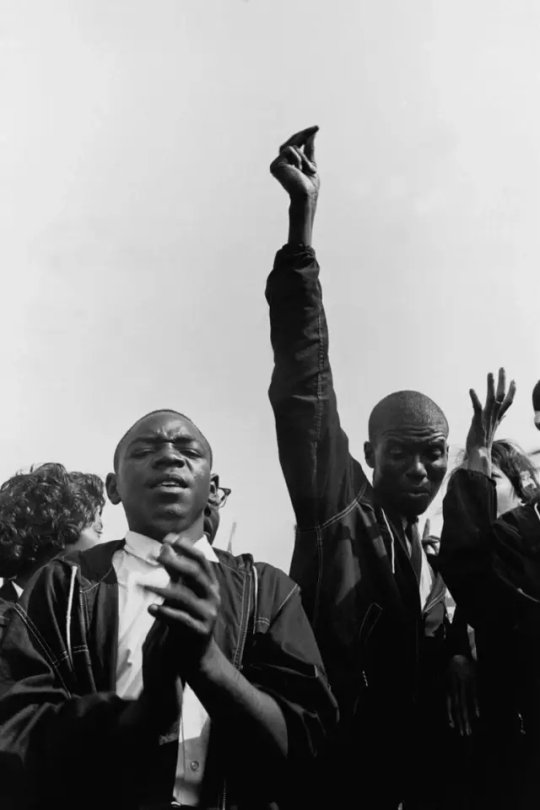
Danny Lyon (American, b. 1942)The March on Washington August 28, 1963 Gelatin silver print 29.8 x 20.8cm (11 3/4 x 8 3/16 in.) Museum of Modern Art, New York; Gift of Anne Ehrenkranz
Galveston
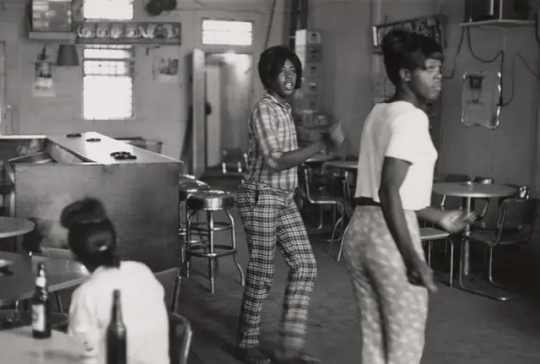
Danny Lyon (American, b. 1942)Pumpkin and Roberta, Galveston, Texas 1967 Gelatin silver print Image: 23.8 x 16.1cm (6 3/8 x 9 3/8 in.) Sheet: 20.3 x 25.4cm (8 x 10 in.) Collection of the artist
Prisons
In 1967, Lyon applied to the Texas Department of Corrections for access to the state prisons. Dr. George Beto, then director of the prisons, granted Lyon the right to move freely among the various prison units, which he photographed and filmed extensively over a fourteen-month period. The result is a searing record of the Texas penal system and, symbolically, of incarceration everywhere.
Lyon’s aim was to “make a picture of imprisonment as distressing as I knew it to be in reality.” This meant riding out to the fields to follow prisoners toiling in the sun, as well as visiting the Wynne Treatment Centre, which housed primarily convicts with mental disabilities. He befriended many of the prisoners, listening to their stories and finding the humanity in their experiences, and still maintains contact with some of them.

Danny Lyon (American, b. 1942)Weight Lifters, Ramsey Unit, Texas 1968 Gelatin silver print Image: 22.4 x 33.2cm (8 7/8 x 13 1/16 in.) Sheet: 27.7 x 35.6cm (11 x 14 in.) Collection of the artist

Danny Lyon (American, b. 1942)New Arrivals from Corpus Christi, The Walls, Texas 1968 Gelatin silver print Image: 21.4 x 32cm (8 7/16 x 12 5/8 in.) Sheet: 27.9 x 35.6cm (11 x 14 in.) Collection of the artist

Danny Lyon (American, b. 1942)Contents of Arriving Prisoner’s Wallet, Diagnostic Unit, The Walls, Huntsville, Texas 1968 Gelatin silver print Image: 24.3 x 17.5cm (9 9/16 x 6 3/4 in.) Sheet: 25.4 x 20.3cm (10 x 8 in.) Collection of the artist
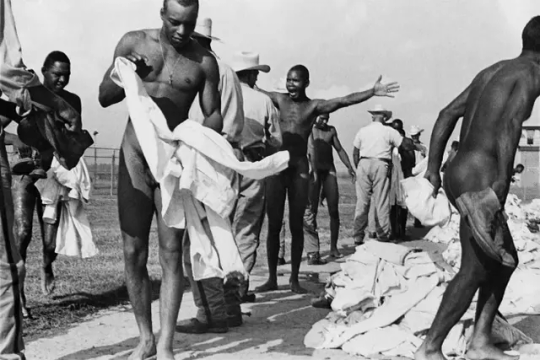
Danny Lyon (American, b. 1942)Shakedown, Ramsey Unit, Texas 1968 Gelatin silver print Image: 17 x 24.2cm (6 5/8 x 9 9/16 in.) Sheet: 20.3 x 25.4cm (8 x 10 in.) Collection of the artist
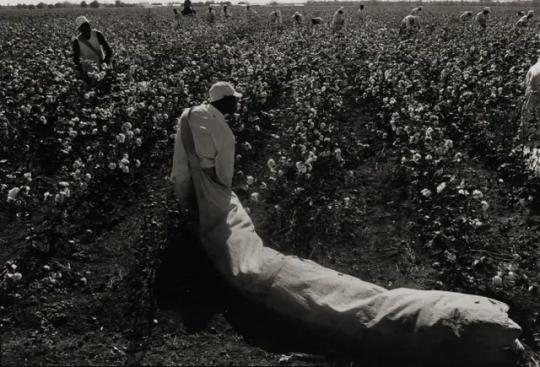
Danny Lyon (American, b. 1942)Convict With a Bag of Cotton, Texas 1968 Gelatin silver print

Danny Lyon (American, b. 1942)Two Inmates, Goree Unit, Texas 1968 Gelatin silver print Image: 16.8 x 24cm (6 5/8 x 9 91/6 in.) Sheet: 20.3 x 25.4cm (8 x 10 in.) Collection of the artist
#Danny Lyon#Leesburg Stockade#Civil Rights Movement#Voting Rights#Texas#Mississippi#Georgia#Alabama#prison#March on Washington#martin luther king jr#black lives matter#atlanta#maryland#sncc
1 note
·
View note
Video
youtube
When the KKK Murdered My Childhood Friend
When the Ku Klux Klan murdered my protector, it made me see the world differently.
I was always the shortest kid in school, which made me an easy target for bullies. To protect myself, I got into the habit of befriending older boys who’d watch my back.
One summer when I was around 8 years old I found Mickey, a kind and gentle teenager with a ready smile who made me feel safe.
Over the years, I lost track of Mickey. It wasn’t until the fall of 1964, my freshman year in college, that I heard what had happened to him.
Several months before, Mickey, whose full name was Michael Schwerner, had gone to Mississippi to register Black voters during what was known as “Freedom Summer.”
On June 21, Michael and two other civil rights workers, James Chaney and Andrew Goodman, were arrested near Philadelphia, Mississippi by Neshoba County Deputy Sheriff Cecil Ray Price, for allegedly speeding.
That night, after they paid their speeding ticket and left the jail, Deputy Price followed them, stopped them again, ordered them into his car, and took them down a deserted road where he turned them over to a group of his fellow Ku Klux Klan members. They were beaten, shot at point-blank range, and buried in an earthen dam. Their bodies weren’t found until August 4.
The state of Mississippi refused to bring charges against any of the Klan members. Eventually, the U.S. Justice Department brought federal charges against Price and 17 others.
An all-white jury found seven of the defendants guilty, including Price. Ultimately none would serve more than six years behind bars.
When the news reached me that Mickey, my childhood protector, had been murdered by white supremacists — by violent bullies who would stop at nothing to prevent Black people from exercising their right to vote — something snapped inside me.
I began to see everything differently. Before then, I understood bullying as a few kids picking on me for being short. Now I saw bullying on a larger scale, all around me. In Black people bullied by whites. In workers bullied by bosses. In girls and women bullied by men. In the disabled or gay or poor or sick or immigrant bullied by employers, landlords, insurance companies, and politicians.
Sixty years after the Freedom Summer murders, America still wrestles with bullies — a rise in hate crimes targeting people of color, LGBTQ people, immigrants, Jews, and Muslims — new laws restricting the right to vote, banning books, and stripping Americans of reproductive freedoms — leaders who insult and demean people with disabilities, women, and trans kids.
We must never give in to cruelty and violence. It is incumbent on all of us to stand up to bullies and be each other’s protectors.
981 notes
·
View notes
Text
I would have bled out in the parking lot
Amber Nicole Thurman's death is on Trump's hands
Bess Kalb
Sep 17
In 2019, about six weeks after my first child was born, I found myself on the bathroom floor in a small, but nonetheless unsettling puddle of blood.
“Oh no,” I remember thinking. “I just did the laundry.”
I called out my husband’s name, but the sound caught in my throat. The pain I felt inhaling to get enough air out of my lungs to yell the two syllables in “Char-lie” jabbed my guts like a bicycle spoke to the abdomen.
So I was quiet, trying to keep breathing in a way that didn’t move anything inside me, and the pain pulsed a bit, then steadied, then dulled, then evaporated into whatever hell ether it came from.
Because there is no G-d (unless there is, in which case I abbreviated His name so as not to desecrate it, and also thank you, King of the Universe, for subscribing to this newsletter) this was the one time in my life I hadn’t brought my phone with me to the bathroom.
I decided to sort of slither-lumber to the door like a lame harbor seal, because I didn’t want to stand and loosen the spoke that had just stabbed me. I reached for the knob and let the door creak open.
The cat was there, looking at me right at eye level, keenly aware what was happening, and completely unmoved by it.
“You are dying,” he blinked, “Pity. Have a nice time.” He sashayed away.
Fortunately, our house in Los Angeles was small enough that from the bathroom door one could see everything. My husband was sitting on the couch with our infant, and I knocked on the open door to summon him. Within one one thousandth of a second, he set the baby on the (since-recalled) donut pillow and was holding my head.
I sat up. I breathed. No pain. I took a picture of the bloody mess on my husband’s phone, texted it to myself, he found my phone, then I texted the picture to my OBGYN.
Apologies for being graphic, but within the puddle there was something roughly the size and shape and color of a fig.
“Is this ok?” I said to my doctor, the bicycle spoke scraping lightly at my insides again from all the lumbering.
“Come in,” she replied.
Within two hours, I was in the waiting room of her office, accompanied by my terrified but SMILING mother, who was still, as is the Jewish custom, in town for “a few days or so” after the birth.
An ultrasound which felt like the finger of Satan himself revealed there was retained placenta in my uterus. If I hadn’t come in, there would have been more hemorrhaging, then sepsis, then whatever the cat foretold.
The next day, I was in surgery getting a Dilation and Curettage.
I went home, pumped the anesthesia milk, then fell asleep perfectly fine, my sweet newborn cooing merrily in the bassinet next to his alive mother.
Amber Nicole Thurman’s story was the same as mine, but it happened to her in Georgia in 2024, not California in 2019. She was a Black woman in a healthcare system that disproportionately kills Black women, especially postpartum. In 2021, the Black maternal mortality rate was nearly three times the rate it is for white women. Post-Roe, the toll is and will continue to be staggering.
Because post-Roe, the procedure that saved my life, the D&C, is something doctors cannot perform in states where matters of life and death have been left up to non-medical Christian-supremacist superstitions.
I know the pain Amber Thurman felt when that placenta dislodged and carved its tiny, treacherous hole in her uterine wall. I know the terror she felt when she saw the blood, and the rush of dread when she thought of what her child would do without her.
And when I vote in November for Kamala Harris and every progressive down-ballot candidate, I will do it because she can’t. And I will do it so that women in Georgia and Idaho and Texas and North Dakota and South Dakota and Utah, Arizona, Nebraska Iowa, Missouri, Arkansas, Louisiana, Mississippi, Alabama, Tennessee, Kentucky, Indiana, Florida, South Carolina, and West Virginia won’t have to meet the same completely preventable doom.
This election isn’t just about Amber Thurman. Every day of my lucky, breathing life is about Amber Thurman. Because the only thing that separates us, is one of us bled out under the right Supreme Court.
Let’s raise absolute federal hell about it.
-- From Bess Kalb's newsletter The Grudge Report. I pay for this substack -- though it's free-- and think this is a message worth sharing far beyond her newsletter.
#bess kalb#the grudge report#abortion#abortion rights#abortion is healthcare#kamala harris#amber thurman
345 notes
·
View notes
Text
Influencer island

“GOOD MORNINGGG AMERICAAAAA”
“I’m your host Yanna Bailey to Influncer Island. It’s new, it’s hot, it’s dramatic, and it’s your new obsession!”
“We’re bringing all of your fav influencers and Internet personalities across the country for a steamy hot adventure”
“You all know them”
“And you all love them”
“I have hand picked these hotties myself…some ofc more known than others none the less they are all wild and ready to come in swinging!”
“Before I introduce you to the men that will participate in influencer island I think it’s fair that I give you a run down of what this show will look like!”
“These 16 hotties will come in ready to pick some partners and participate in challenges”
“Each pair will receive points based off of where they place on the board and based off votes from the viewers aka you guys”
“At the end of each episode there will be a poll placed for voting”
“You guys will be able too vote who should stay, go, and receive a punishment, or a hot date”
“With that being said let’s introduce the men of INFLUENCER ISLAND.

“Coming in first we have the famous polo boy himself”

“Armin Arlert”!
“He’s best known on instagram for being the cute polo soft boy model as stated in his bio, the internet has named him the number 1 golden retriever baby and I couldn’t agree more!”
“Armin is such a sweet heart and I know he can’t wait to be here….but with him being a sweetie pie…will he be able to hang and get wild with the rest of the contestants?”
“Especially this chipped tooth, beer drinking, horse riding, dirty country boy gone viral”
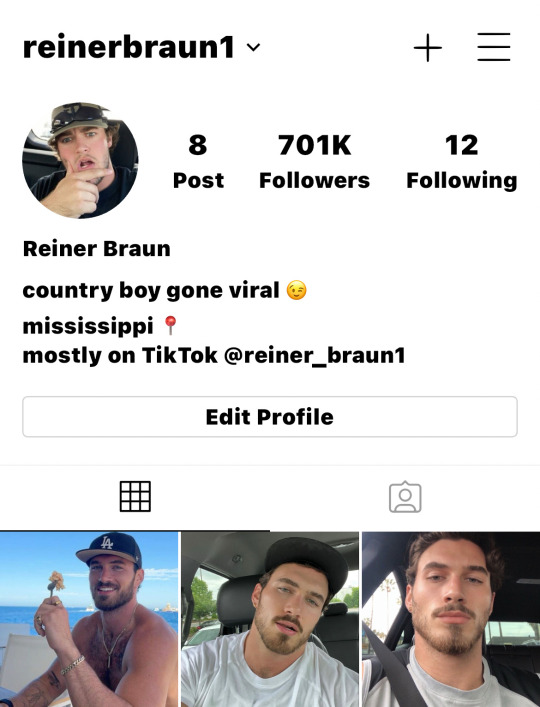
“Reiner Braun”!!
“This big beefy boy best known on that clock app has gone viral for bringing his southern ways onto the app, Reiner caught the attention of many wild men and sexy ladies and was requested by the merrier”
“Currently living in Mississippi but we all know he’s a real south Floridian gator wrestling boy. He’s the perfect match for this cast”
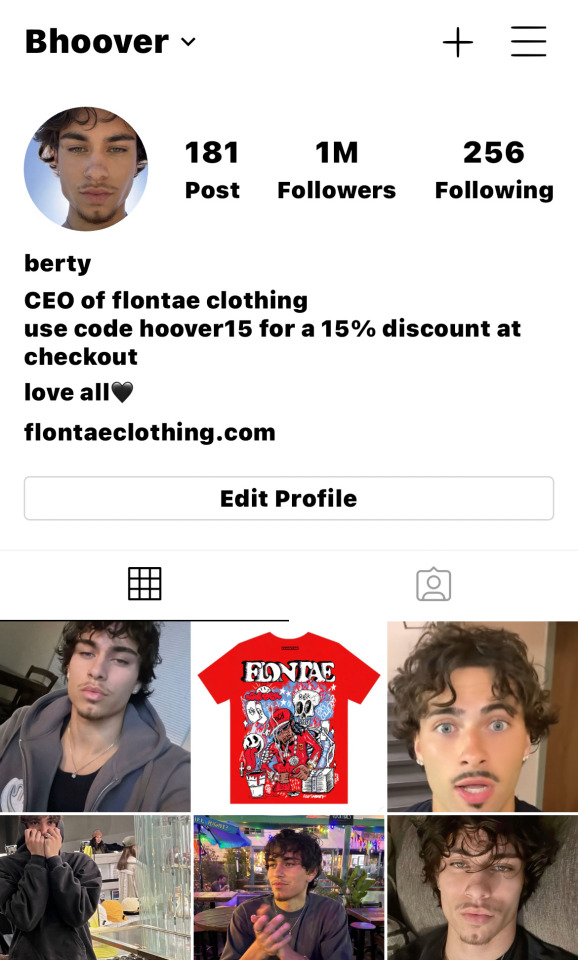
“Next up we got this black cat clothing owner bertoldt hoover!!”
“Best known for his brand flontae clothing and getting hella wild on them boats, don’t let the pretty eyes fool you this city boy knows how to party”

“Kristen made that cast Okay!”
“Y’all know him cause he definitely produced your favorite songs”
“He’s worked with Nicki Minaj, lil Wayne, drake, lil durk, Kanye west, and so many more”
“However when he’s not in that Stu making beats he’s out hosting the biggest parties and filming it all letting us know he was a perfect candidate for this cast!”

“This hot head was requested by the executive producer herself, we’ve seen him whoop ass in that underground ring, we’ve seen him getting wild in the streets, we’ve seen him catchin ass on twt and we wanna see MOREEE!!”
“Everyone love porco”
“But I don’t think as much as y’all love this sexy stoner”

“Constance springer the man that you are”
“He’s 6’0 tatted like a chipotle bag and he is the life of the party! This skater boy most known on TikTok and YouTube is definitely  influential and definitely deserves his spot here

“As stated himself he is a fine chocolate sexy black man”
“Get this! He’s also a brand ambassador for flontae clothing who would’ve known”
“Onyankapon, such a pretty name for a pretty boy.”
“We don’t know how wild ony gets and that’s why he was picked cause the whole world wants to see, he’s seen as someone who doesn’t do much. But I’m willing to bet as soon as he steps foot on this sand that will change.”
“And last but certainly not least”.

“Eren Yeager.”
“Or jaeger”
“Regardless this man dose not need an intro at all, you’ve seen him right with Beyoncé on her ivy park campaign”
“You’ve seen him on the front page of Louis Vuitton”
“You all love him and rightfully so he is something else sporting that black motorcycle when he’s not doing them photo shoots”
“You see these men? These are who are gonna be across your screens in the next few weeks!! Now just imagine the women.”
“On the next preview we will be introducing your favorite wild ladies! It’s your host Yanna Bailey signing out!”
How do you guys feel?😁
(Not proofread)
#aot fandom#black writers#black reader#connie springer#onyankopon smut#connie smut#armin arlet headcanons#eren x black reader#eren jeager smut#connie springer x black reader smut#snk reiner#reality tv au#porco galliard#bertholdt hoover#onyankopon x black y/n#aot onyankopon#aot imagines#aot jean#aot connie#eren x you
518 notes
·
View notes
Text
there's this song in the stage musical version of Annie--of which i only remember the hook and not the verses which aren't very good--which is the residents of a Hooverville singing @ Herbert Hoover
"We'd like to thank you Herbert Hoover..." about how much they hate him, right. because they're homeless.
Which ofc is reminiscent of the 'thanks Obama' meme to me, but also ofc means I'm thinking about Herbert Hoover, cuz the refrain to this mediocre song is looping in my head.
And the thing is, Herbert Hoover did not cause the Great Depression. Right? Inasmuch as it was a result of misgovernance, it was the fruit of decisions made before he was in office.
He did, however, mishandle the crisis fairly badly. Not, like, Trump-during-Covid levels of fail, but not helping, either.
But I happen to know that the rage at him had, in context, an additional element that isn't important enough to make it into history courses. Which is that Herbert Hoover made his national reputation as the point man on getting aid to parts of Europe devastated in World War I.
So kind of like with Dr. Fauci--he was the face of something people on average felt good about the government doing, and it was believed he'd done a decent job.
Before he got into government he'd been a high-level coordinator with the Red Cross, which I learned about in passing in this book about the history of criminalization, because he organized aid after massive flooding of the Mississippi forced large-scale evacuations.
(And there are folk songs from that period about why you don't go down to that Red Cross store for a bag of flour, because the Red Cross was collaborating with law enforcement, which was being really intense about escaped slaves black people who had Voluntarily Signed ludicrously exploitative labor contracts using the disruption to Get Away. Anyway.)
So the thing is, people had voted for Herbert Hoover understanding him as a person who provided aid to the dispossessed. This was his image. Even the people who didn't like him thought he was that kind of guy! So when he absolutely did not mobilize the federal government to save his own people during a crisis, the deep sense of betrayal was personal. Not merely the institutions but the individual had let the people fall.
And that's why he got blamed harder than most presidents who have shit fall apart on their watch.
This has been American History With Earworms.
250 notes
·
View notes
Text
On Oct. 29, 1920, the temperature in Detroit reached a high of 60 degrees, and the Detroit Free Press reported that “Northwestern High’s football eleven” was preparing to face Eastern High School the next day for a much anticipated Saturday matchup at the Joyce athletic field.
Julia Esaw had not yet arrived in Detroit to enjoy the game and the pleasant weather, but the longtime member of People’s Community Church was born on that day — more than 100 years ago.
And this past Tuesday, on Oct. 29, the same Julia Esaw celebrated her 104th birthday in Detroit.
“If you could see my face now, you would see a great big smile,” Esaw announced by phone at 3:27 p.m. on her birthday, a day that was fittingly even warmer in Detroit than the day she was born.
Asking the exuberant centenarian to take a second call by FaceTime so that her beautiful smile could be seen was not an option. That’s because Esaw was in a rush to quickly take in the sun and 76-degree warmth that radiated at that moment near her Detroit home, not far from her beloved People’s Community Church — 8601 Woodward Ave. — before she was to be whisked away to a secret location for a family birthday celebration.
A 104th birthday is a rare occurrence. But Esaw says that from a very early time in her life she came to expect good experiences in Detroit.
“Detroit has had a lot to offer and I have no complaints,” said the 1939 Cass Tech graduate, who came to Detroit with her family when she was 2 years old from Columbia, Mississippi.
During the afternoon of Monday, Oct. 28, with vivid recollection, Esaw reeled off some of the early Detroit streets she lived on, including High Street, Division, Brewster, Hedge, Trowbridge and Taylor. However, it was a discussion about a destination that Esaw visited recently that brought out an excited tone a little more than eight hours before her birthday. That destination is 2978 West Grand Blvd., home to the Detroit Department of Elections, where Esaw dropped off her absentee ballot with a vote cast in the 2024 presidential election for Democratic Vice President Kamala Harris. And Esaw left no doubt that even with all of the history she has seen during her long lifetime, the opportunity to cast her vote for Harris — the first Black woman to head a major party’s presidential ticket — holds a special place in her heart.
“I’m happy and it makes me feel great!” declared Esaw, who was born just 72 days after the ratification of the 19th Amendment which legally guaranteed women the right to vote.
Then Esaw went on to explain that her happiness this election season is tied to progress she has witnessed during her lifetime.
“After high school, I wanted to study to be a dietitian. But as a young Black woman, there was no place here that I could go to get the training and my mother didn’t want me to go away,” lamented Esaw, who says she still owes a huge debt of gratitude to two “tough” teachers in Cass Tech’s home economics curriculum that prepared her well for life. “Blacks didn’t have the same kind of power we have today. But if we all get together now, we can put her (Harris) on the top seat.”
Although Esaw was unable to pursue a career in health care, her journey as a beautician actually began in close physical proximity to a prominent Detroit health institution.
“I started as a beautician at the Streamline Beauty Shop on Forest and it was right across from Women’s Hospital (now Hutzel Women’s Hospital),” said Esaw, who was married to the late Tuskegee Airman Burkes Esaw Sr. “Because we were so close to the hospital, I had more white trade (clientele) than Black. It was the same thing for many years when I was running my own shop.”
In the roles Esaw carried out as a beautician, block club president, wife and mother of four children who were taught at home to value education and healthy eating, she says race was not a barrier to success. But Esaw’s recollection of a revered Detroit landmark — the old downtown J. L. Hudson Department Store — may be a bit different from what is recorded in many history books. Esaw explained that there was a time when the shopping experience for Black customers at J.L. Hudson, which grew to be the tallest department store in the world during its heyday, was mostly relegated to the basement level due to a Northern version of Jim Crow.
Esaw’s earliest memories of Hudson’s were shared without a hint of bitterness in her voice and with a tiny chuckle thrown in because, as Esaw went on to explain, she has never accepted a “basement” view of life due to her faith. And because of her faith, Esaw says the fact that a Black woman (Harris also is of Southeast Asian descent on her mother's side) has a very legitimate chance to become the nation’s first woman president is not really a big surprise to her.
“I was always taught that we (Black people) were God’s children too,” said Esaw, who noted that she starts each morning with a bowl of assorted raw fruit that she prepares for herself. “God made us and we’re somebody, too. And we can do anything that anyone else can, including being president.”
And in an equally succinct manner, Esaw laid out what she would expect from Harris as president.
“I want to see her reach out and touch everybody, because we’re all God’s children,” Esaw stated. “And then I would like to see us all work together as a team.”
Next to Esaw as she spoke from home on consecutive afternoons beginning Oct. 28 was her only daughter and constant companion, 72-year-old Berneta Esaw, a retired Detroit Public Schools math teacher. Berneta Esaw was with her mother when she dropped off her election ballot, and she also was by her mom’s side on Oct. 12 at the Detroit Golf Club when Berneta Esaw’s 1969 Cass Tech graduating class held its 55th reunion, which Julia Esaw used as an opportunity to celebrate the 85th anniversary of her own graduation from Cass.
Berneta Esaw says she is holding out hope that there are other living people that will come forward who graduated from Cass Tech in or around 1939 to allow her mother to enjoy a reunion experience to the fullest. But in the meantime, Berneta Esaw is more than happy to share lessons for living a long, fulfilling life — which she has received with love directly from her mother.
“Mother doesn’t look anywhere close to 90 — most people start at 70 when she asks them how old they think she is. But she has worked hard to look like that,” said Berneta Esaw, who has grown accustomed and accepting to people that want to hug and touch her mom when they become aware of Julia Esaw’s age. “Living with mother, you knew you were going to get your fruit in the morning, and salad with lunch and dinner, because mother knows that when you eat fresh, raw fruits and vegetables the body works better.
“Mother is a blessing, and I feel blessed that I was born to two parents who were extremely knowledgeable and intelligent, and they gladly passed down their knowledge to my siblings and me, and others in our community.”
56 notes
·
View notes
Photo
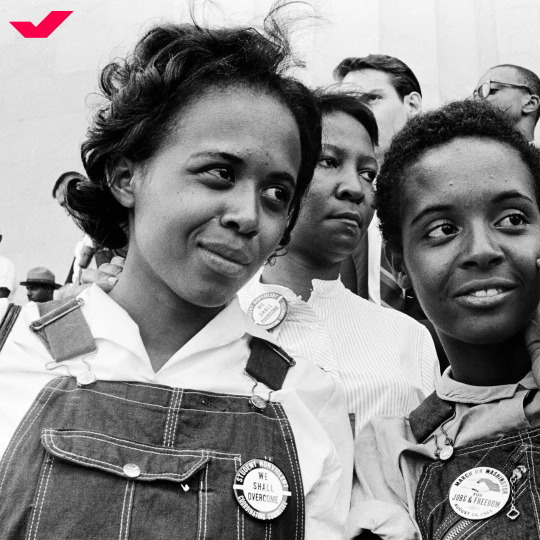
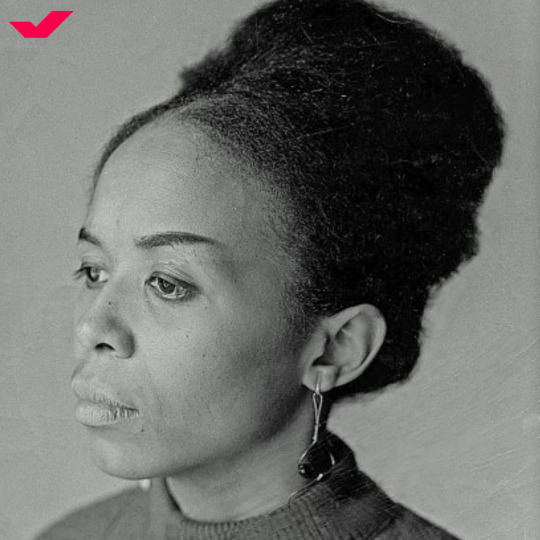
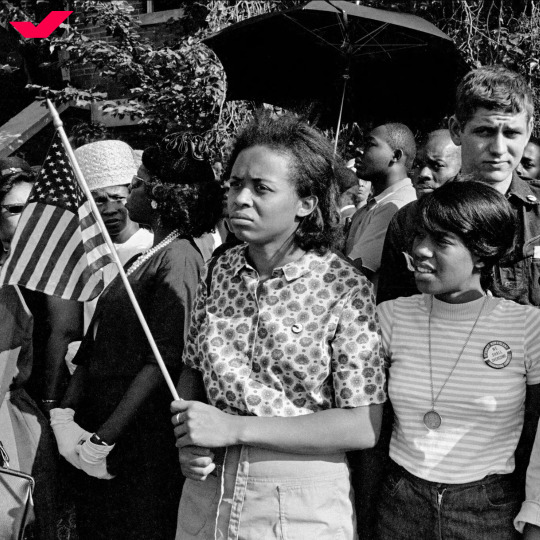
We are saddened to hear about the passing of Dorie Ann Ladner, lifelong voting rights activist. 🕊️🗳️
Ms. Ladner participated in every major civil rights protest of the 1960s, including the March on Washington and the march from Selma to Montgomery, Alabama. She was a key organizer in her home state of Mississippi, with contributions to the NAACP and Student Nonviolent Coordinating Committee. In June 1964, she launched a volunteer campaign called “Mississippi Freedom Summer,” with a goal of registering as many Black voters as possible.
We remember and honor Dorie through the words of her sister and fellow activist, Joyce Ladner: as someone who “fought tenaciously for the underdog and the dispossessed,” and “left a profound legacy of service.”
#dorie ladner#dorie ann ladner#voting rights#civil rights#women's history month#mississippi#naacp#sncc#student nonviolent coordinating committee#black voters#black voter#activist#1960s
366 notes
·
View notes
Text
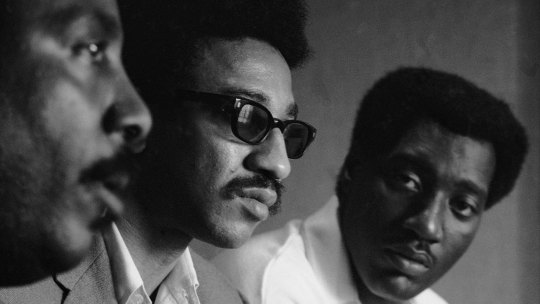
Jamil Abdullah al-Amin (born Hubert Gerold Brown; October 4, 1943), is an American human rights activist, Muslim cleric, African separatist, and convicted murderer who was the fifth chairman of the Student Nonviolent Coordinating Committee (SNCC) in the 1960s. Best known as H. Rap Brown, he served as the Black Panther Party's minister of justice during a short-lived (six months) alliance between SNCC and the Black Panther Party.
He is perhaps known for his proclamations during that period, such as that "violence is as American as cherry pie", and that "If America don't come around, we're gonna burn it down." He is also known for his autobiography, Die Nigger Die! He is currently serving a life sentence for murder following the shooting of two Fulton County, Georgia, sheriff's deputies in 2000.

Brown's activism in the civil rights movement included involvement with the Student Nonviolent Coordinating Committee (SNCC). Brown was introduced into SNCC by his older brother Ed. He first visited Cambridge, Maryland with Cleveland Sellers in the summer of 1963, during the period of Gloria Richardson's leadership in the local movement. He witnessed the first riot between whites and blacks in the city over civil rights issues, and was impressed by the local civil rights movement's willingness to use armed self-defense against racial attacks.
Brown later organized for SNCC during the 1964 Mississippi Freedom Summer, while transferring to Howard University for his studies. Representing Howard's SNCC chapter, Brown attended a contentious civil rights meeting at the White House with President Lyndon B. Johnson during the Selma crisis of 1965 as Alabama activists attempted to march for voting rights.
Major federal civil rights legislation was passed in 1964 and 1965, including the Voting Rights Act, to establish federal oversight and enforcement of rights. In 1966, Brown organized in Greene County, Alabama to achieve African voter registration and implementation of the recently passed Voting Rights Act.
Elected SNCC chairman in 1967, Brown continued Stokely Carmichael's fiery support for "Black Power" and urban rebellions in the Northern ghettos.
During the summer of 1967, Brown toured the nation, calling for violent resistance to the government, which he called "The Fourth Reich". "Negroes should organize themselves", he told a rally in Washington, D.C., and "carry on guerilla warfare in all the cities." They should, "make the Viet Cong look like Sunday school teachers." He declared, "I say to America, Fuck it! Freedom or death!"

In this period, Cambridge, Maryland had an active civil rights movement, led by Gloria Richardson. In July 1967 Brown spoke in the city, saying "It's time for Cambridge to explode, baby. Black folks built America, and if America don't come around, we're going to burn America down." Gunfire reportedly broke out later, and both Brown and a police officer were wounded. A fire started that night and by the next day, 17 buildings were destroyed by an expanding fire "in a two-block area of Pine Street, the center of African-American commerce, culture and community." Brown was charged with inciting a riot, due to his speech.
Brown was also charged with carrying a gun across state lines. A secret 1967 FBI memo had called for "neutralizing" Brown. He became a target of the agency's COINTELPRO program, which was intended to disrupt and disqualify civil rights leaders. The federal charges against him were never proven.
He was defended in the gun violation case by civil rights advocates Murphy Bell of Baton Rouge, the self-described "radical lawyer" William Kunstler, and Howard Moore Jr., general counsel for SNCC. Feminist attorney Flo Kennedy also assisted Brown and led his defense committee, winning support for him from some chapters of the National Organization for Women.
The Cambridge fire was among incidents investigated by the 1967 Kerner Commission. But their investigative documents were not published with their 1968 report. Historian Dr. Peter Levy studied these papers in researching his book Civil War on Race Street: The Civil Rights Movement in Cambridge, Maryland (2003). He argues there was no riot in Cambridge. Brown was documented as completing his speech in Cambridge at 10 pm July 24, then walking a woman home. He was shot by a deputy sheriff allegedly without provocation. Brown was hastily treated for his injuries and secretly taken by supporters out of Cambridge.
Later that night a small fire broke out, but the police chief and fire company did not respond for two hours. In discussing his book, Levy has said that the fire's spread and ultimate destructive cost appeared to be due not to a riot, but to the deliberate inaction of the Cambridge police and fire departments, which had hostile relations with the African community. In a later book, Levy notes that Brice Kinnamon, head of the Cambridge police department, said that the city had no racial problems, and that Brown was the "sole" cause of the disorder, and it was "a well-planned Communist attempt to overthrow the government."
While being held for trial, Brown continued his high-profile activism. He accepted a request from the Student Afro-American Society of Columbia University to help represent and co-organize the April 1968 Columbia protests against university expansion into Harlem park land in order to build a gymnasium.
He also contributed writing from jail to the radical magazine Black Mask, which was edited and published by the New York activist group Up Against the Wall Motherfucker. In his 1968 article titled "H. Rap Brown From Prison: Lasima Tushinde Mbilashika", Brown writes of going on a hunger strike and his willingness to give up his life in order to achieve change.
Brown's trial was originally to take place in Cambridge, but there was a change of venue and the trial was moved to Bel Air, Maryland, to start in March 1970. On March 9, 1970, two SNCC officials, Ralph Featherstone and William ("Che") Payne, died on U.S. Route 1 south of Bel Air, when a bomb on the front floorboard of their car exploded, killing both occupants. The bomb's origin is disputed: some say the bomb was planted in an assassination attempt, and others say Payne was carrying it to the courthouse where Brown was to be tried. The next night, the Cambridge courthouse was bombed

Brown disappeared for 18 months. He was posted on the Federal Bureau of Investigation's Ten Most Wanted List. He was arrested after a reported shootout with officers in New York City following an alleged attempted robbery of a bar there. He was convicted of robbery and served five years (1971–76) in Attica Prison in western New York state. While in prison, Brown converted to Islam. He formally changed his name from Hubert Gerold Brown to Jamil Abdullah al-Amin.
After his release, he moved to Atlanta, Georgia, where he opened a grocery store. He became an imam, a Muslim spiritual leader, in the National Ummah, one of the nation's largest African Muslim groups. He also was a community activist in Atlanta's West End neighborhood. He preached against drugs and gambling. It has since been suggested that al-Amin changed his life again when he became affiliated with the "Dar ul-Islam Movement"

On May 31, 1999, al-Amin was pulled over while driving in Marietta, Georgia by police officer Johnny Mack for a suspected stolen vehicle. During a search, al-Amin was found to have in his pocket a police badge. He also had a bill of sale in his pocket, explaining his possession of the stolen car, and he claimed that he had been issued an honorary police badge by Mayor John Jackson, a statement which Jackson verified. Despite this, al-Amin was charged with speeding, auto theft and impersonating a police officer.
On March 16, 2000, in Fulton County, Georgia, Sheriff's deputies Ricky Kinchen and Aldranon English went to al-Amin's home to execute an arrest warrant for failing to appear in court over the charges. After determining that the home was unoccupied, the deputies drove away and were shortly passed by a black Mercedes headed for the house. Kinchen (the more senior deputy) noted the suspect vehicle, turned the patrol car around, and drove up to the Mercedes, stopping nose to nose. English approached the Mercedes and told the single occupant to show his hands. The occupant opened fire with a .223 rifle. English ran between the two cars while returning fire from his handgun, and was hit four times. Kinchen was shot with the rifle and a 9 mm handgun.
The next day, Kinchen died of his wounds at Grady Memorial Hospital. English survived his wounds. He identified al-Amin as the shooter from six photos he was shown while recovering in the hospital[citation needed] Another source said English identified him shortly before going into surgery for his wounds.
After the shootout, al-Amin fled Atlanta, going to White Hall, Alabama. He was tracked down by U.S. Marshals who started with a blood trail at the shooting site, and arrested by law enforcement officers after a four-day manhunt. Al-Amin was wearing body armor at the time of his arrest. He showed no wounds. Officers found a 9 mm handgun near his arrest site. Firearms identification testing showed that this was used to shoot Kinchen and English, but al-Amin's fingerprints were not found on the weapon. Later, al-Amin's black Mercedes was found with bullet holes in it.
His lawyers argued he was innocent of the shooting. Defense attorneys noted that al-Amin's fingerprints were not found on the murder weapon, and he was not wounded in the shooting, as one of the deputies said the shooter was. A trail of blood found at the scene was tested and did not belong to al-Amin or either of the deputies. A test by the state concluded that it was animal blood, but these results have been disputed because there was no clear chain of custody to verify the sample and testing process. Deputy English had said that the killer's eyes were gray, but al-Amin's are brown.
At al-Amin's trial, prosecutors noted that he had never provided an alibi for his whereabouts at the time of the shootout, nor any explanation for fleeing the state afterward. He also did not explain why the weapons used in the shootout were found near him during his arrest.
On March 9, 2002, nearly two years after the shootings, al-Amin was convicted of 13 criminal charges, including Kinchen's murder and aggravated assault in shooting English. Four days later, he was sentenced to life in prison without possibility of parole (LWOP).He was sent to Georgia State Prison, the state's maximum-security facility near Reidsville, Georgia.
Otis Jackson, a man incarcerated for unrelated charges, claimed that he committed the Fulton County shootings, and confessed this two years before al-Amin was convicted of the same crime. The court did not consider Jackson's statement as evidence. Jackson's statements corroborated details from 911 calls following the shooting, including a bleeding man seen limping from the scene: Jackson said he knocked on doors to solicit a ride while suffering from wounds sustained in the firefight with deputies Kinchen and English. Jackson recanted his statement two days after making it, but later confessed again in a sworn affidavit, stating that he had only recanted after prison guards threatened him for being a "cop killer". Prosecutors refuted Jackson's testimony, claiming he couldn't have shot the deputies as he was wearing an ankle tag for house confinement that would have showed his location. Al-Amin's lawyers allege that the tag was faulty.
Al-Amin appealed his conviction on the basis of a racial conspiracy against him, despite both Fulton County deputies being black. In May 2004, the Supreme Court of Georgia unanimously ruled to uphold al-Amin's conviction.
In August 2007, al-Amin was transferred to federal custody, as Georgia officials decided he was too high-profile for the Georgia prison system to handle. He was first held in a holdover facility in the USP Atlanta; two weeks later he was moved to a federal transfer facility in Oklahoma, pending assignment to a federal penitentiary.
On October 21, 2007, al-Amin was transferred to ADX Florence, a supermax prison in Florence, Colorado. He has been under an unofficial gag order, prevented from having any interviews with writers, journalists or biographers.
On July 18, 2014, having been diagnosed with multiple myeloma, al-Amin was transferred to Butner Federal Medical Center in North Carolina. As of March 2018, he is incarcerated at the United States Penitentiary, Tucson.
Al-Amin sought retrial through the 11th Circuit Court of Appeals. Investigative journalist, Hamzah Raza, has written more about Otis Jackson's confession to the deputy shootings in 2000, and said that this evidence should have been considered by the court. It had the potential of exonerating al-Amin. However, the 11th Circuit Court of Appeals rejected his appeal on July 31, 2019.
In April 2020, the U.S. Supreme Court declined to hear an appeal from al-Amin. His family and supporters continue to petition for a new trial.
#african#afrakan#kemetic dreams#africans#brownskin#brown skin#afrakans#african culture#afrakan spirituality#h rap brown#Jamil Abdullah al-Amin#Black Panther Party#black panthers#kwame ture#fred hampton#civil rights#civil rights movement#malcolm x
84 notes
·
View notes
Text
On June 9, 1963, Fannie Lou Hamer and other civil rights activists were arrested in Winona, Mississippi, while returning from a voter education workshop in South Carolina. Mrs. Hamer and the other activists had been traveling in the "white" section of a Greyhound bus despite threats from the driver that he planned to notify local police at the next stop. When the bus arrived at the Winona bus depot, some of the activists attempted to eat at Staley's Cafe but were refused service.
Mrs. Hamer, who had stayed on the bus, soon saw police officers arresting some of the activists. She got off the bus and was seized by a white police officer who began kicking her and arrested her. In August 1964, while testifying at the Democratic National Convention to urge party bosses to seat a group of Black Mississippi voters as delegates, Mrs. Hamer recalled the abuse she endured that night at the county jail.
"It wasn't too long before three white men came to my cell," she said. "One of these men was a state highway patrolman and he asked me where I was from. I told him Ruleville and he said, 'We are going to check this.' They left my cell and it wasn't too long before they came back. He said, 'You are from Ruleville all right,' and he used a curse word. And he said, 'We are going to make you wish you was dead.'"
The white officers then forced two African American prisoners to brutally beat Mrs. Hamer with loaded blackjacks; she was nearly killed. As Mrs. Hamer regained consciousness, she overheard one of the white officers propose, "We could put them SOBs in [the] Big Black [River] and nobody would ever find them."
Mrs. Hamer suffered from life-long injuries following the attack, including permanent kidney damage. Mrs. Hamer died in 1977 at age 59. Lawyers with the Student Nonviolent Coordinating Committee (SNCC) filed suit against the Winona police who brutalized the activists, but an all-white jury acquitted them. Despite the trauma she experienced, Mrs. Hamer returned to Mississippi to continue organizing and remained active in civil rights causes until her death.
#history#white history#us history#Fannie Lou Hamer#June 9 1963#June 9#civil rights#Black history#Winona#Mississippi#voting rights#vote#Greyhound bus#bus driver#racist#racism#white supremacy#white section#segregated#segregation#racial segregation#police#police officer#law enforcement officer#law enforcement#police brutality#police cowardice#defund the police#bad police#dirty cops
0 notes
Photo
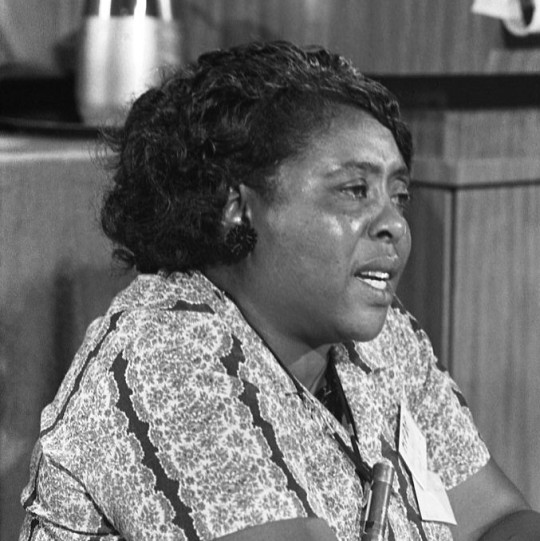
On this day, 9 June 1963, Black civil rights activist Fannie Lou Hamer was arrested on trumped up charges and brutally beaten in jail. Hamer had become a voting rights activist, and was on her way home to Mississippi from a voter registration workshop in South Carolina when she was arrested with other activists. In detention, a Mississippi police officer ordered two other prisoners to beat Hamer with a blackjack. Hamer and her activist friends were beaten brutally, and although charges were dropped and she was released three days later it took her over a month to recover and she was left blind in one eye and with kidney damage which contributed to her premature death at the age of 59. The Student Nonviolent Coordinating Committee sued the local police department for the attack, but the perpetrators were acquitted by an all-white jury. Previously in 1961, Hamer had been sterilised without her consent or knowledge by a white doctor, who was acting according to Mississippi authorities' plan to reduce the poor Black population of the state. Despite the violence she was subjected to, Hamer continued her civil rights activism until her death. More information, sources and map: https://stories.workingclasshistory.com/article/10916/fannie-lou-hamer-arrested https://www.facebook.com/photo.php?fbid=641368961369656&set=a.602588028581083&type=3
372 notes
·
View notes